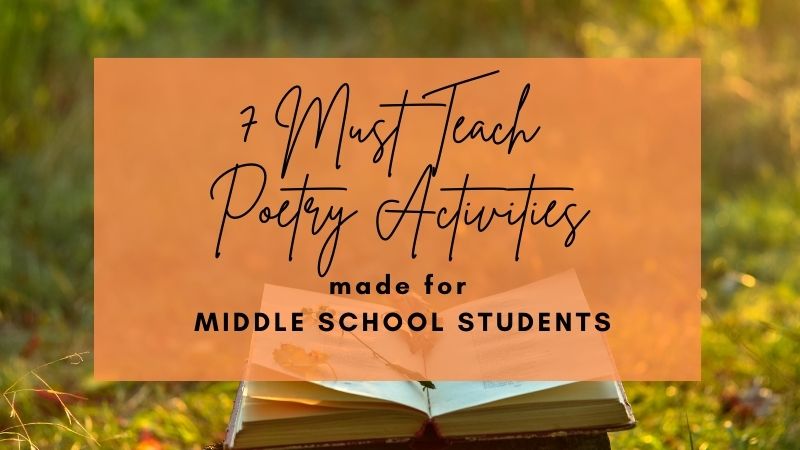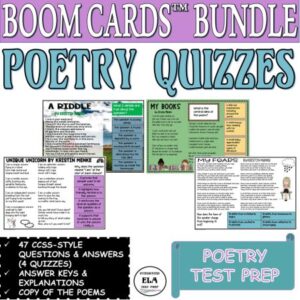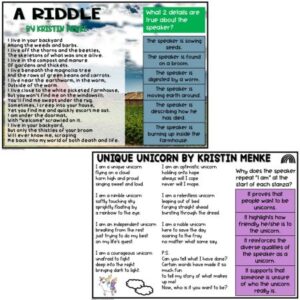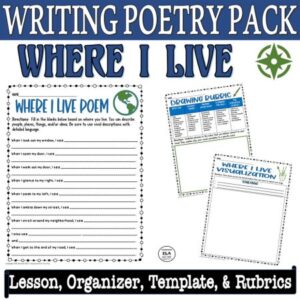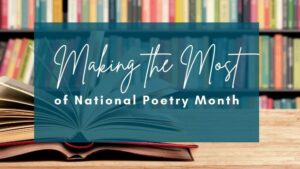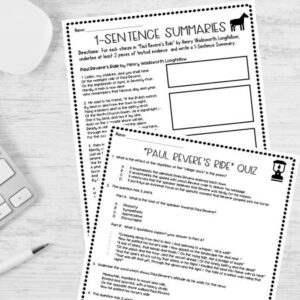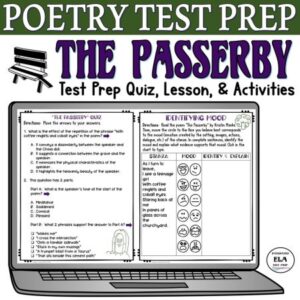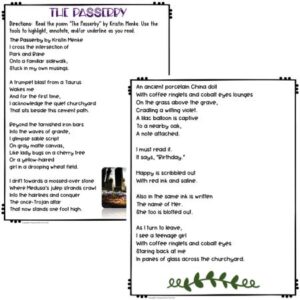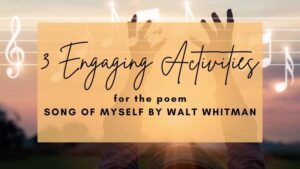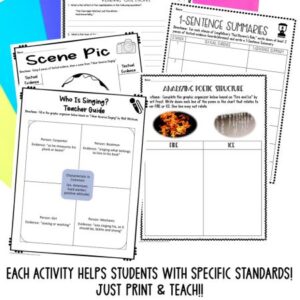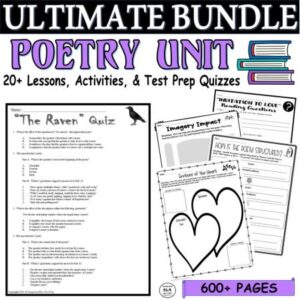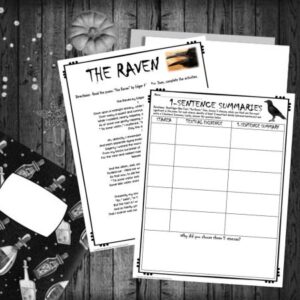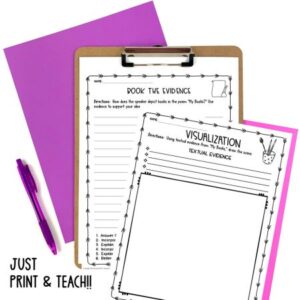7 Must Teach Middle School Poetry Activities-I am not sure about you, but I have a tough time teaching poetry! First, you have to decide what poems inspire you and will inspire your students. Then, you have to figure out what standards or skills you want to teach. Finally, you need to choose the assignments that your students will need to produce to show you what they have learned!
If you are teaching middle school students, it can be even more difficult. So many poems can be too simple and cute like “At the Zoo” by William Makepeace Thackeray, or they can be super high level like John Donne’s “Death Be Not Proud.” But we know that middle schoolers are a different breed altogether when it comes to age, ability, and attitude!
Middle school students are out of the elementary stage. They are willing to take risks, experience new things, make their own decisions, and just go for it…whatever it is 🙂 So, as teachers, we can take advantage of their willingness to try new things, and that includes reading new texts like poetry. We don’t, however, want to frustrate our students. We want them to become engaged and stay engaged.
Read on for 7 Must Teach Middle School Poetry Activities!
Need help with Test Prep? Check out this FREE Pack of 3 Test Prep Activities to help students achieve success on standardized tests!

7 Must Teach Middle School Poetry Activities
1. Poetry BOOM™ Cards
If you haven’t tried out BOOM™ Learning, check out this online platform that makes teaching poetry just a LOT more fun! You can set up a classroom for a yearly fee (it’s around $15 for up to 50 students), assign various activities in quiz-like formats, and get data for your classroom and for individual students! Check out my store Integrated ELA Test Prep for poetry quizzes that connect to the standards!
2. Poetry Writing Templates
I am a huge fan of helping students through the use of templates! Using an already created format can assist our students who want to write but don’t know how to get started. This Poetry Writing Pack encourages students to write about where they live with specific, detailed language. Make writing poetry fun and accessible with this NO PREP lesson and middle school poetry activities!
3. Poetry Device Analysis
Poetry is so much fun, because it challenges us with the rhythm, rhymes, sounds, and images we can see and hear! Edgar Allan Poe’s “The Bells” includes a ton of onomatopoeia and “My Fears” by Kristin Menke incorporates lots of alliteration. You could have students choose a literary device, find a poem that contains that device, and explain this device to the class, after they read the poem of course!
Here are some devices you can focus on:
- Sounds: alliteration, consonance, assonance
- Figurative Language: metaphor, simile, hyperbole, personification, anthropomorphism, oxymoron, etc. See HERE for more!
- Syntax: rhythm, internal rhyme, end rhyme, beats, etc.
Want to include some Edgar Allan Poe Poems this year? Read about Edgar Allan Poe Love Poems!
4. Celebrate National Poetry Month in April
National Poetry Month in the month of April is a time to read, enjoy, and celebrate poetry and poets that really connect with who we are! In 1996, the Academy of American Poets decided that we needed a month dedicated to making the everyday person aware of the people and poems that inspire us in so many ways. Whether you like reading poems by celebrated authors Maya Angelou and Paul Laurence Dunbar, acting out the dramatic poems of Edgar Allan Poe, or basking in the Romantics like Percy Bysshe Shelley or William Wordsworth, there is a poem for every student during National Poetry Month!
5. Integrate Poetry With Social Studies, Physical Education, Science, & Electives
Integration is my jam! I love weaving everything together in a beautiful tapestry of learning through middle school poetry activities. Nothing needs to be taught in isolation. Instead, we can help students make connections with every topic they encounter!
- Civil Rights & “Harlem” by Langston Hughes
- Civics & “I Hear America Singing” by Walt Whitman
- Plants & “I Wandered Lonely as a Cloud” by William Wordsworth
- Amphibians & “A Frog Who Would Not Move” by Kristin Menke
- Phases of the Moon & “I Saw the Moon One Time” by Kristin Menke
- Ancient Civilizations & “Ozymandias” by Percy Bysshe Shelley
- American Revolution & “Paul Revere’s Ride” by Henry Wadsworth Longfellow
- Physical Science & “Fire and Ice” by Robert Frost
- British History & “The Charge of the Light Brigade” by Alfred, Lord Tennyson
- Music & “Song of Myself” by Walt Whitman
- Film & “The Bells” by Edgar Allan Poe
- Mental Health & “My Fears” by Kristin Menke
- Math/Measurements & “My Shadow” by Robert Louis Stevenson
- Zoology & “At the Zoo” by William Makepeace Thackeray
- Geography & “Where I Live” Poetry Template by Kristin Menke
6. Poetry Writing Responses
When it comes to teaching middle school poetry activities, you don’t really want to read it and move on. You want students to respond in some way. You could have students answer questions about characterization, theme, structure, etc. in quick responses, paragraph-long responses, or in full essays. My personal preference is the short response. When students don’t have to write a ton, I see more of a willingness to do the work!
Here is an example based on the poem “The Passerby” by Kristin Menke! Click the picture below to get easy-to-teach middle school poetry activities!
Short Response: How does the author of “The Passerby” use imagery to set the mood of the poem? Use evidence to support your ideas.
Short Response Paragraph: Sentence-By-Sentence
- Answer the question by referring to the mood
- Incorporate a piece of evidence; be sure to embed the quote
- Explain how the evidence links to the mood
- Incorporate another piece of evidence; be sure to embed the quote
- Explain how the evidence links to the mood
- Reiterate how imagery impacts mood
Want to integrate teaching songs with middle school poetry activities? Check out Poem Song of Myself: 3 Engaging Activities!
7. Middle School Poetry Activities That Incorporate Test Prep
So often, our kids enter the test prep season with trepidation. We totally get it, right? If you incorporate some test prep involving poetry throughout the year within your middle school poetry activities, it will help students prepare for what they might encounter on the state standardized test 🙂
These tests might ask students to cite evidence, determine the central idea or theme, analyze how a character develops, examine how the text starts and ends, and think about the author’s choice of words and descriptions. By including these standards in what you teach, we can have fun with teaching poetry and teaching for test success!
Check out these examples from Robert Frost’s poem “Fire and Ice!”
What is the effect of the repetition of the word “some?”
- A. It portrays that people have varying beliefs.
- B. It highlights that the fire is greater than the ice.
- C. It confirms the argument that people think in the same way.
- D. It establishes the idea that the earth’s end with affect several people.
What is the tone of the poem?
- A. Hopeful
- B. Meditative
- C. Depressing
- D. Disappointed
If you want middle school poetry activities for several weeks, click below!
Why should we teach middle school poetry activities throughout the year?
Sharing what we love about language and learning is the ultimate goal! So many students encounter poetry through songs, and making poetry connect to music could also be a fantastic way to relate to students. We come into contact with poetry through lyrics whether from an artist we love or an advertisement or a greeting card or even a jingle we just can’t get out of our heads.
Let’s help our students out by teaching them to love literature, no matter the form, through middle school poetry activities!
Want more help teaching middle school poetry activities? Check out my store, Kristin Menke-Integrated ELA Test Prep!

